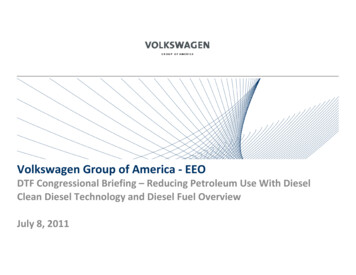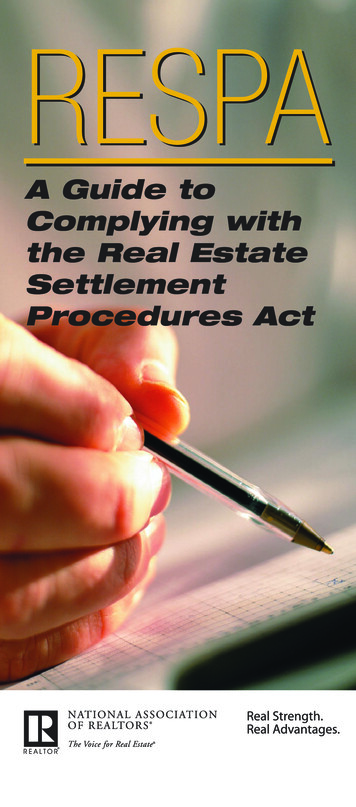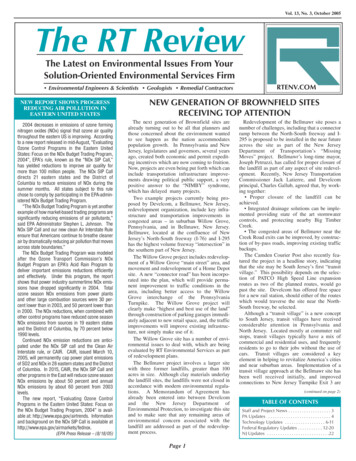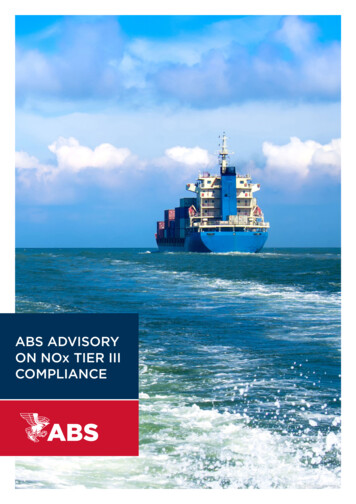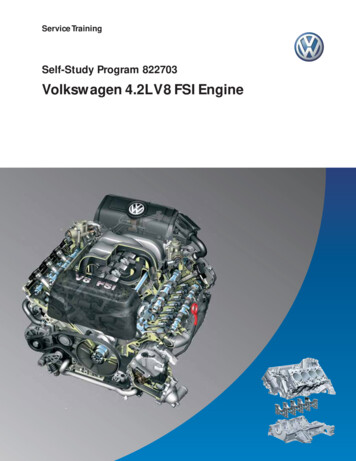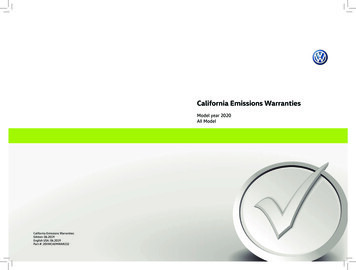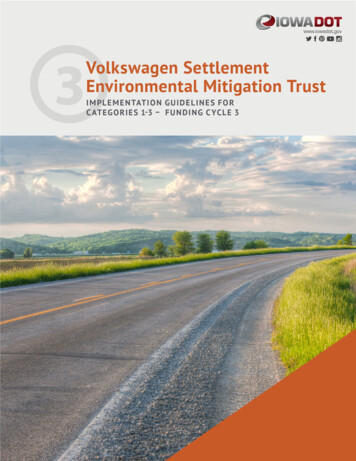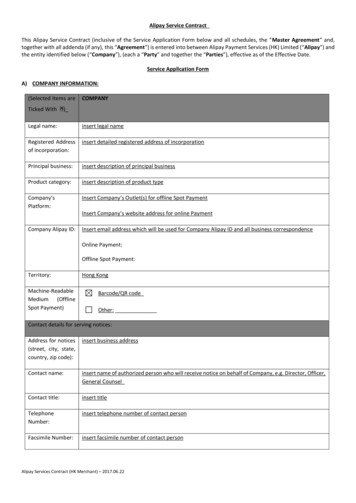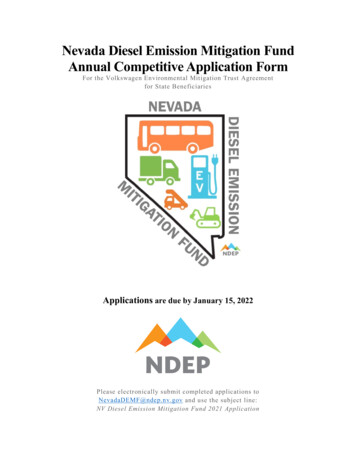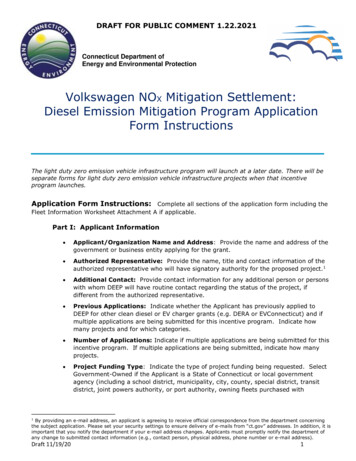
Transcription
DRAFT FOR PUBLIC COMMENT 1.22.2021Connecticut Department ofEnergy and Environmental ProtectionVolkswagen NOX Mitigation Settlement:Diesel Emission Mitigation Program ApplicationForm InstructionsThe light duty zero emission vehicle infrastructure program will launch at a later date. There will beseparate forms for light duty zero emission vehicle infrastructure projects when that incentiveprogram launches.Application Form Instructions: Complete all sections of the application form including theFleet Information Worksheet Attachment A if applicable.Part I: Applicant Information Applicant/Organization Name and Address: Provide the name and address of thegovernment or business entity applying for the grant. Authorized Representative: Provide the name, title and contact information of theauthorized representative who will have signatory authority for the proposed project. 1 Additional Contact: Provide contact information for any additional person or personswith whom DEEP will have routine contact regarding the status of the project, ifdifferent from the authorized representative. Previous Applications: Indicate whether the Applicant has previously applied toDEEP for other clean diesel or EV charger grants (e.g. DERA or EVConnecticut) and ifmultiple applications are being submitted for this incentive program. Indicate howmany projects and for which categories. Number of Applications: Indicate if multiple applications are being submitted for thisincentive program. If multiple applications are being submitted, indicate how manyprojects. Project Funding Type: Indicate the type of project funding being requested. SelectGovernment-Owned if the Applicant is a State of Connecticut or local governmentagency (including a school district, municipality, city, county, special district, transitdistrict, joint powers authority, or port authority, owning fleets purchased withBy providing an e-mail address, an applicant is agreeing to receive official correspondence from the department concerningthe subject application. Please set your security settings to ensure delivery of e-mails from “ct.gov” addresses. In addition, it isimportant that you notify the department if your e-mail address changes. Applicants must promptly notify the department ofany change to submitted contact information (e.g., contact person, physical address, phone number or e-mail address).1Draft 11/19/201
government funds), and a tribal government or native village. Otherwise, selectPrivately-OwnedDraft 11/19/202
Part II: Project InformationA. Project Summary: Proposed Project Title: Provide a title for the proposed project. Anticipated Dates: Provide an anticipated project start date and end date. Project Summary: Provide a brief summary of the project, includingcommunity and air quality benefits. This is the opportunity for the Applicant topromote the energy, environmental and economic benefits of the proposedproject. (If form is filled electronically, the cell will expand, use separatepage(s) if completing the form manually.)oVehicle/Equipment/Engine Use: Indicate the use of thevehicle/equipment/engine being replaced or repowered.oArea of Operation: Indicate the geographical area in which thevehicle/equipment/engine spends the majority of its time operating.(This may be different from the applicant’s business address.)B. Project Documentation Project Category: Select only one of the project categories listed by checkingthe associated box. Only one category should be selected per application. Ifapplying for more than one project category, use a separate form for each. Complete the applicable subsection for the selected project category andprovide the listed documentation required:oB.1 Replacement or Repower of On-Road Heavy Duty VehiclesoB.2. Replacement or Repower of Non-Road EquipmentoB.3. Repower or Engine Upgrade for Commercial Marine VesselsoB.4. Shorepower for Ocean-Going VesselsoB.5. Replacement or Repower of Locomotives (Freight Switchers) EV Charging Infrastructure: Complete only if the applicant is replacingvehicles, engines or equipment with an electric equivalent and installingassociated charging infrastructureoProvide the type, brand, model, number of chargers, and number ofoutlets of any associated charging equipment being installed.oProvide the name of the facility, street address, and/or latitude/longitudeof the proposed location of this project.oApplicants must have site control2 over the location of the proposed EVcharging station installation site. Documentation of ownership may berequested.Site Control means (1) ownership of, a leasehold interest in, or a right to develop a site for the purpose of constructing theEV Charging Station; (2) an option to purchase or acquire a leasehold site for such purpose; or (3) an exclusivity or otherbusiness relationship between the Applicant and the entity having the right to sell, lease or grant the Applicant the right topossess or occupy a site for such purpose. Documentation of ownership may be requested for verification.2Draft 11/19/203
oProvide specification sheets for equipment for the EV charginginfrastructure.oProvide all estimates for equipment, site preparation, installation andlabor for the EV charging infrastructure.oWhile public access is not required for the charging stations installed inconjunction with EV replacements/repowers under this grant, if thecharging stations will be publicly-accessible, the Applicant may besubject to the conditions of Public Act 16-135, the relevant portions ofwhich are codified in Section 16-19f, Section 16-19ggg, and subsection bof Section 43-3 of the Connecticut General Statutes.3C. Proposed Budget for Replacement/Repower Projects: Provide the number of new vehicles/equipment/engines being purchased; thetype of vehicle (e.g. front loader refuse truck), make, model and year of eachnew vehicle/equipment/engine; and the total cost for each group ofvehicles/equipment/engines being purchased. (For example, if replacing sixType C school buses, in the first row of the table enter the make, model andyear of the replacements as a group. If you are replacing a combination of TypeC and Type B school buses, enter the Type B school buses info in the secondrow of the table. This would also apply for a combination of heavy andmedium-duty trucks, etc.) Provide the installation cost (labor and materials) of the vehicle/equipment/engine. If EV charging infrastructure is being installed as part of a project that isrepowering/replacing with new electric vehicles/equipment/engines, provide thecost of equipment, labor and materials for the site preparation and installationof the charging stations. Note that it is not unusual for the site preparation andinstallation costs to exceed the cost of the charging equipment. Describe any other expenses anticipated for the project and enter the cost.Examples might include transformer upgrades or installing cable and conduit toprovide for additional EV charging stations in the future. Note that these“Other” costs may not be eligible for funding. Provide answers to the questions for project costs including:o Anticipated VW Grant AwardoGrantee Cost ShareoDo you anticipate a down payment and if so how much?oBalance of Vehicle/Equipment/Engine Cost after down payment - theBalance of Vehicle/Equipment Costs can be calculated by subtracting thedown payment from the project total (Remaining Project Costs Projecttotal – Down Payment) Attach all estimates and specification sheets for vehicles, equipment, engine,materials and labor for the project.Public Act 16-135 can be found on the Connecticut General Assembly website 135-R00HB-05510-PA.pdf.3Draft 11/19/204
D. Proposed Budget for Shorepower Projects: Provide the number, brand, model and total cost of the shorepower units to beinstalled. Provide the cost of labor and materials for the site preparation and installationof the shorepower units. Note that it is not unusual for the site preparation andinstallation costs to exceed the cost of the shorepower equipment. You may include cables, cable management systems, shore power couplersystems, distribution control systems, and power distribution costs as part of theproject’s total cost. Describe any other expenses anticipated for the project and enter the cost.Note that these “Other” costs may not be eligible for funding. Provide the name of the facility, street address, and/or latitude/longitude of theproposed location of this project. Applicants must have site control over the location of the proposed shorepowerinstallation. Documentation of ownership may be requested. Attach all estimates and specification sheets for equipment, materials and laborfor the project.E. Balance of Funds: the Mitigation Plan specifies the maximum funding that can beawarded to a project, however, the maximum funding is not guaranteed. Funding isnot guaranteed before awards are made. Applicants will be notified of the actualamount awarded for their project after the project application has been reviewed. Theapplicant will also have the opportunity, at that time, to accept or refuse the award.Note: This is a reimbursement program; applicant is responsible for all project costsprior to reimbursement. Checking this box is signifies that the Applicant can provide the balance of thefunds needed to complete the project. Identify the source of the funds the Applicant will secure to complete the project(i.e. Town budget, capital account, loan, other grant or incentive program). Indicate any time line involved, such as Town budget or similar processes,requiring approvals. Indicate whether the vehicle or equipment will be purchased or leased.Draft 11/19/205
Part III: Preferential Criteria: Proposed projects should be cost effective (includingconsideration of the applicant’s ability to provide matching funds), and have potential forcompletion by XX, 202X. Proposed projects will be ranked based on a set of criteria reflectingfunding priorities for the program. The criteria include, but are not limited to the tableprovided. It is important to note that the list is of preferential funding criteria, not eligibilitycriteria.Check all that apply on the application form. NOx Benefit Calculations: If a projected NOX benefit has been calculated for theproject, indicate the quantifier used and print your input and output data to be submittedwith the application. Retain the electronic copy; it may be requested during the reviewprocess. DEEP will be crosschecking these projections against EPA’s Diesel EmissionsQuantifier (DEQ)4 for consistency. Environmental Justice: Projects in environmental justice (EJ) communities5 that arelisted on the DEEP website. Check the box if the vehicles covered by your projectoperate primarily in a geographical area that is considered an EJ community. This is notnecessarily the same as the applicant’s address. Transformative/Innovative: A “transformative or innovative” project is one that hassufficient size, scope or importance to initiate momentum for sustainability andexpansion beyond the scope of this program and has the potential for replicationthroughout the transportation sector. Replacing a box truck is neither transformativenor innovative; converting one or multiple fleets to electric or alternative fuel could beregarded as transformative/innovative.”6 If the project is consideredtransformative/innovative, provide an explanation. County Location: If the proposed project is located in Fairfield, Middlesex or NewHaven counties, select the county where the vehicle, equipment, or engine primarilyoperates. While all of CT is in nonattainment for ozone, Fairfield, Middlesex and NewHaven counties are also maintenance areas for fine particulates and therefore ofincreased interest for mitigation projects. GHG Reduction: If the project will result in a significant reduction in emissions ofcarbon dioxide or other greenhouse gases, check the box and identify the quantifier usedto calculate the emissions reductions and the amount of reduction anticipated. Print yourquantifier input and output data and submit with the application. Retain the electroniccopy; it may be requested during the review process. Demonstrated Experience: If Applicant can demonstrate how past experience orexisting program structure can facilitate successful implementation of proposed project,check associated box and explain. Cost Share: If Applicant has verified funding that exceeds the minimum requiredcost share, check associated box and explain sources of leveraged funding, amount ofSee EPA’s Diesel Emissions Quantifier at uantifier-deq. Show yourentries, assumptions and results. If you use another calculation tool, identify the tool.5Find lists of Connecticut EJ communities at: nvironmental-JusticeCommunities .6For other possible examples, see Connecticut’s 2018 Comprehensive Energy Strategy at: omprehensiveEnergyStrategypdf.pdf and the Electric Vehicle Roadmap for Connecticut: APolicy Framework to Accelerate Electric Vehicle Adoption (EV Roadmap), released in April of 2020, on the DEEP website dmap.4Draft 11/19/206
leveraged funding, and if funding is already secured. Include any additional informationthat may be helpful. EPA SmartWay Membership: If applicant is an active participant in EPA’s SmartWayprogram,7 Check this box and provide the year in which applicant became active. Consistent with DEEP Program Goals: If project is consistent with the transportationsection of the Comprehensive Energy Strategy for Connecticut and the state’s EVRoadmap,8 check this box and explain. Idling: If Applicant currently has, or the proposed project includes a motor vehicle antiidling education and outreach program, check associated box, explain and provide proofof the anti-idling program.Part IV: Terms & Conditions: After the application has been completed, the applicationmust be reviewed and signed by the authorized representative listed in Part I. The signaturecertifies that, to the best of the Applicant’s knowledge and belief, the information contained inthe application, including all attachments, is true, accurate and complete. An application willbe considered insufficient unless the required signature is provided and all supportingdocumentation has been submitted.Part V: Submission: Mail the completed form and all supporting documentation toCentral Permit Processing UnitConnecticut Department of Energy & Environmental Protection79 Elm StreetHartford, CT 06106-5127 All Inquiries should be directed to the DEEP’s Bureau of Air Management - Planning andStandards Division at DEEP.MobileSources@ct.gov.7For information regarding EPA’s SmartWay program or to enroll, go to https://www.epa.gov/smartway.Electric Vehicle Roadmap for Connecticut: A Policy Framework to Accelerate Electric Vehicle Adoption(EV Roadmap), releasedin April of 2020, can be found on the DEEP website at ap.8Draft 11/19/207
Attachment A: Fleet Information Worksheet: This section provides instructions forthe Fleet Information Worksheet, which applies to repower or replacement projects only.Information required on this sheet is broken into two sections: information on the existingfleet (vehicles, engine or equipment to be replaced) and information on the new, replacementvehicles, engines or equipment. It is recommended that the spreadsheet be completedelectronically and a copy printed for submission. Retain the electronic copy; it may berequested during the review process. Applicant Name: The name of the government or business entity applying for thegrant. Type of Project: Select the project type from the drop down list. This shouldmatch the selection made in Part II.B of the application form. A separate sheet andapplication form should be used for different project types.Before filling out vehicle information, the “Type of Project” must be selected.Selecting a project type affects the data requested and changes to the sheet will notoccur unless a selection is made. ID: A unique name or number ID assigned by the applicant to each vehicle. Type of Equipment: Select the vehicle or equipment type that is being replacedfrom the drop down list. NOTE: The options in this field change based on the typeof project that applicant has selected above.Existing Fleet VehiclesDraft 11/19/20 Engine Make: The manufacturer of the engine. Engine Model: The specific name or number used to indicate the differencebetween multiple engines of the same make. Engine Serial Number: The engine serial number is usually found on a plateattached to the engine block. Horsepower: The maximum power the engine produces. Engine Model Year: The year in which the engine was manufactured. This is notalways the same as the vehicle or equipment model year. If a 2009 MY engine wasinstalled in a 2010 MY vehicle, the vehicle would be eligible for the program,whereas, if a 2010 MY engine was installed in a 2010 MY vehicle, that vehicle is noteligible. The engine model year should appear on the serial number plate attachedto the engine block. For non-road equipment engines, California has provided aguide at el-year.pdf fordetermining model year. The next column in the worksheet will automatically update with one of thefollowing headings based on the type of project selected above.oPrimary Town(s) of Vehicle Operation: For on-road diesel andlocomotive projects only. Indicate the primary town or towns in which thevehicle operates. If operation of vehicle is statewide, enter “statewide”.oMarine Engine Cylinder Displacement: For marine projects only. Thecylinder displacement of the marine engine, in liters or liter equivalents.8
o Vehicle Identification Number (VIN): The identifying code for a specific vehicle.The VIN can usually be found on the dashboard, on the driver’s side of the vehicle,or on a sticker or plate inside the driver’s door. Gross Vehicle Weight Rating (GVWR): The maximum weight of the vehicle, asspecified by the manufacturer, including total vehicle weight plus fluids,passengers, and cargo. See Figure 1 below for GVWR based vehicle classifications,along with examples of vehicle types in those classes. Eligible vehicle types couldappear in any GVWR class and this graphic is not meant to be all-inclusive. Vehicle Class: The classification given to a vehicle based on its gross vehicleweight rating. This field will automatically populate based on the GVWR previouslyentered Current Fuel Type: The type of fuel currently being used in thevehicle/equipment/engine being repowered/replaced. Annual Fuel Usage: The amount of fuel used in a calendar year in the vehicle,equipment, or engine being repowered or replaced. Annual Mileage/Operating Hours: This column will automatically update to oneof the following based on the type of project selected above. Draft 11/19/20Forklift Lift Capacity: For forklifts only. The total lifting capacity of forkliftequipment, in pounds or pound equivalents.oAnnual Mileage: The number of miles added, in a calendar year, to theodometer of the vehicle being repowered/replaced.oAnnual Operating Hours: The number of hours a piece of equipment orengine being repowered or replaced is operated in a calendar year.Annual Mileage/ Operating Hours in CT: This column will automatically updateto one of the following based on the type of project selected above.oAnnual Mileage in CT: The number of miles driven on Connecticut roadsand highways in one year. If records of Connecticut mileage are notavailable, provide an estimate of annual mileage in Connecticut.oAnnual Operating Hours in CT: The number of hours non-road equipmentor engines operate in Connecticut in one year. If records are not available,provide an estimate of the annual number of hours in Connecticut.Vehicle Annual Idling Hours: The number of hours a vehicle or equipment idlesin a calendar year. If records of idling hours are not available, provide an estimateof annual idling hours and indicate that it is an estimate when entering on the form(e.g. 200 hrs. est.).9
Miles per Gallon/Gallons per Hour: This column will automatically update andcalculate the appropriate value based on the type of project selected above.oMiles per Gallon: The calculated fuel economy based on the annual fuelusage of a vehicle, and the annual miles.oGallons per Hour: The calculated fuel economy based on the annual fuelusage of non-road equipment, and the annual hours of operation.Proposed New Fleet VehiclesDraft 11/19/20 New Vehicle or Equipment Information: As explained above for the existingfleet information section, enter the following for the new replacement vehicles orequipment: Engine Make, Engine Model, Horsepower, Engine Model Year, ProjectType Specific Information, and GVWR. Vehicle Class will be updated automatically. Estimated Fuel Economy: The manufacturer’s or vendor’s estimated fuel usagerate for the new engine in miles per gallon or, if the project is for non-roadequipment, gallons per hour. If the new equipment operates on an alternative fuel,provide the information in diesel equivalents. New Vehicle/Equipment Fuel Type: Select the fuel type of the new vehicle,engine or equipment from the dropdown list. Unit Cost: The estimated cost of the new vehicle, engine, or equipment. Do notinclude any labor, installation, or related costs.10
Figure 1: Vehicle Class and Example Vehicle Types based on Gross Vehicle Weight RatingDraft 11/19/2011
CPPU USE ONLYApp #:Program: VW Grant – DieselNo fee requiredDiesel Emission Mitigation ProgramApplication FormProposals for Use of VW NOX Mitigation Funds for Diesel Emission ReductionProjectsComplete all sections of this form including Attachment A: Fleet Information Worksheet, if applicable.According to the terms of the consent decree, all documentation submitted in support of the fundingrequest and all records supporting all expenditures of Eligible Mitigation Action funds shall be madepublicly available. All proposals must be submitted to the address indicated in Part V of thisform and must be received by 4:00 PM on XX, 202X to be considered.Part I: Applicant InformationApplicant/Organization Name:Address:City:State:Zip Code:Authorized Representative Name:Authorized Representative Title:E-Mail:Telephone:Additional Contact Name:(Optional)E-Mail:Telephone:Additional Contact Name:(Optional)E-Mail:Telephone:Have you previously submitted a proposal to DEEP for cleandiesel or EV charger funding?YesAre you submitting applications for multiple project categoriesunder this Incentive Program? If so, how many?Yes:Type of Project Funding RequestedDraft 10/23/20NoNoGovernment-ownedPrivately-owned1
Part II: Project InformationAny awarded funding must be used only for eligible projects as listed in VW’s EnvironmentalMitigation Trust Agreement for State Beneficiaries.Projects initiated prior to filing an application for the program are not eligible for fundingand submittal of an application is not a guarantee that a proposed project will be funded. Projectinitiation activities that can disqualify an application include initiating an RFP, selecting a Vendor,ordering vehicles, equipment, and engine or hiring a contractor.It is in the applicant’s best interest to delay any vehicle, equipment, or engine purchase until afterfunding is awarded. Any project not awarded for funding under this program, may be eligible toapply for funding under the Diesel Emission Reduction Act (DERA) program provided the project wasnot initiated prior to the solicitation period of the DERA program.A. Project SummaryProposed Project Title:Anticipated Project Start Date:Anticipated Project End Date:Project Summary:Provide a detailed description of the proposed project, including community and air quality benefits. Also, includethe usage of the old vehicle in the summary and area in which it operates.Draft: 10/23/202
B. Project DocumentationSelect a project category. Only one category should be selected per proposal. If applying for morethan one project category below, use a separate form for each. For the project category selected,provide the documentation required and check the associated box.Replacement or Repower of On-Road Heavy Duty Vehicles:Class 8 Local Freight Trucks and Port Drayage Trucks; Class 4-8 SchoolBus, Shuttle Bus, or Transit Bus; and Class 4-7 Local Freight TrucksCompleteSection B.1Replacement or Repower of Non-Road Equipment:Airport Ground Support Equipment, Forklifts and Port Cargo HandlingEquipmentCompleteSection B.2Repower or Engine Upgrade for Commercial Marine Vessels:Ferries and TugsCompleteSection B.3Shorepower for Ocean-Going VesselsCompleteSection B.4Replacement or Repower of Locomotives: Freight SwitchersCompleteSection B.5B.1. Replacement or Repower of On-Road Medium and Heavy Duty Vehicles:Replacement/repower may be with new diesel or alternate fueled engine (e.g., compressed naturalgas (CNG), propane, and hybrid); costs of installation of the engine may be included.Select all applicable vehicle categories below and enter quantity of vehicles beingreplaced/repowered.Vehicle CategoryApplicableQTYClass 8 Local Freight Truck9Port Drayage Truck10Class 4-7 TruckClass 4-8 School BusClass 4-8 Shuttle BusClass 4-8 Transit Bus9“Class 8 Local Freight, and Port Drayage Trucks (Eligible Large Trucks)” shall mean trucks with a Gross Vehicle Weight Rating(GVWR) greater than 33,000 lbs. used for port drayage and/or freight/cargo delivery (including waste haulers, dump trucks,concrete mixers).10“Drayage Trucks” shall mean trucks hauling cargo to and from ports and intermodal rail yards.Draft: 10/23/203
Submit the following supporting documentation for On-Road Heavy Duty Vehicles Category:Completed Attachment A: Fleet Information WorksheetCertificate of Origin or other documentation certifying that each vehicle to bereplaced has been operating in Connecticut for at least five years.For projects including the installation of EV charging infrastructure: providedocumentation demonstrating that applicant has site control11 of the proposedinfrastructure site.Attach all specification sheets for vehicles, equipment and engines for the project.Attach all estimates for vehicles, equipment, engines and labor for the project.For School Bus Projects: If project is for a privately owned bus under contract with apublic school district, provided the duration and expiration date of the existingcontract.Contract DurationExpiration DateB.2. Replacement or Repower of Non-Road Equipment:Airport Ground Support Equipment, Forklifts and Port Cargo Handling EquipmentSelect all applicable equipment categories below and enter quantity of vehicles beingreplaced/repowered.Equipment CategoryApplicableQTYAirport Ground Support Equipment: EV replacements onlyForklifts: EV replacements only; must have lift capacity 8000 lbs.Port Cargo Handling Equipment: EV replacements onlySubmit the following supporting documentation for the Non-Road Equipment Category:Completed Attachment A: Fleet Information WorksheetProvide documentation (e.g. usage log) that the nonroad equipment has been usedmore than 500 hours in the twelve months preceding this application.For projects including the installation of charging infrastructure: providedocumentation demonstrating that applicant has site control3 of the proposedinfrastructure site.Attach all specification sheets for vehicles, equipment and engines for the project.Attach all estimates for vehicles, equipment, engines and labor for the project.11Site Control means (1) ownership of, a leasehold interest in, or a right to develop a site for the purpose of constructing theEV Charging Station; (2) an option to purchase or acquire a leasehold site for such purpose; or (3) an exclusivity or otherbusiness relationship between the Applicant and the entity having the right to sell, lease or grant the Applicant the right topossess or occupy a site for such purpose. Documentation for verification may be requested.Draft: 10/23/204
B.3. Repower or Engine Upgrade for Commercial Marine Vessels:Ferries and TugsSelect all applicable vessel categories below and enter quantity of vessels and engines beingreplaced/repowered.Vehicle CategoryApplicableNumberof VesselsNumber ofPropulsionEnginesNumber ofAuxiliaryEnginesFerryTugType of Replacement/Repower:Unregulated, Tier 1 or Tier 2 diesel engines are being replaced with new Tier 3 or Tier4 diesel or alternate fueled engines, or with all-electric enginesUnregulated, Tier 1 or Tier 2 diesel engines are being upgraded with an EPA CertifiedRemanufacture System or an EPA Verified Engine Upgrade.Submit the following supporting documentation for the Commercial Marine Vessels Category:Provide documentation (e.g. a ferry schedule) that the Marine engine has beenoperating 1,000 or more hours in the twelve months preceding this application.Completed Attachment A: Fleet Information WorksheetAttach all specification sheets for vessels, equipment and engines for the project.Attach all estimates for vessels, equipment, engines and labor for the project.B.4. Shorepower for Ocean-Going Vessels:May include cables, cable management systems, shore power coupler systems, distributioncontrol systems, and power distribution.Address of Proposed Installation:Provide name of facility, street address, streetintersection and/or latitude/longitude and cityMarine shore power system will comply with international shore power designstandards (ISO/IEC/IEEE 80005-1-2012 High Voltage Shore Connection Systems orthe IEC/PAS 80005-3:2014 Low Voltage Shore Connection Systems) and will besupplied with power sourced from the local utility grid.Submit the following supporting documentation f
Volkswagen NO X Mitigation Settlement: Diesel Emission Mitigation Program Application Form Instructions Draft 11/19/20 1 The light duty zero emission vehicle infrastructure program will launch at a later date. There will be separate forms for light duty zero emission vehicle infrastructure projects when that incentive program launches.
